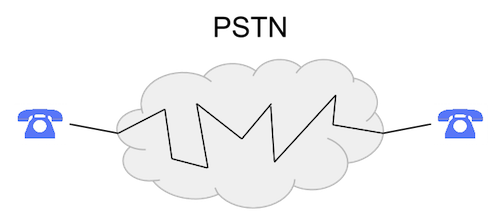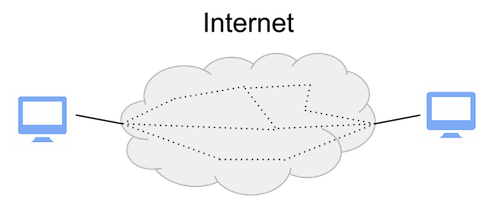
January 04, 2017
This is the third post in our Life of a Call series by Dialpad co-founder and VP of Telephony and Mobile, John Rector. Previously, John worked at Google as a Senior Software Engineer, building the telephony backend for Google Voice.
Part 1: The Historical Telephone
Part 2: PSTN and Modern Telephony
Today we're taking a look at the internet and the separation of data and voice.
Time division multiplexing and circuit switched networks
Traditional telephony across the PSTN (Publicly Switched Telephone Network) is based on Time Division Multiplexing (TDM). This refers to how users share large transmission lines for making long-distance calls. These large trunk lines handle multiple calls by giving each user a certain, very well-defined time slot to send their signal.

Each color represents a different channel that is assigned to single user. Dark shades are time slots that contain data. Light colors are time slots that are reserved but not being used.
Another key related concept is the Circuit Switched Network. While you are constantly sharing trunk lines with other people, in classic PSTN you always have a single unbroken line from telephone A to telephone B. This is same as the physical, electrical circuit in early 20th century telephone exchanges.

Packet switched networks
Packet switched networks (PSN) operate by a different paradigm. Networks that operate by this principle split the data stream into packets of a small, well-defined size. These packets are sent across the network, and it is left to the routers to choose the best path, based on which neighboring router is closest and available.

Packets usually travel the same path to their destination, but there is no guarantee or even an expectation that they will. Similarly, there is no guarantee that these packets will arrive at the destination at a given rate, at a given time, or even at all.
The PSN paradigm works well for computer files (images and HTML webpages), since it is not necessary that portions of a file all arrive at a certain time. A computer can simply store the packets as they arrive, and once the packets have all been received, reassemble the file.
There are several advantages of packet-switching over traditional circuit-switching. The first is efficiency. In traditional TDM, if no data is being sent (no one is speaking in a voice call), then there is a lot of unused capacity that the transmission line could have been using to send something else.
The second advantage is robustness. New routers can be easily installed on the network, and different paths can be taken if one router goes down. Furthermore, TDM requires very accurate clocks that are all synchronized together so that they know exactly which slot is assigned to which user. Otherwise, you could be pulling bits from the wrong slot and cause bit errors.
The unity of voice and data
A long-standing goal of the telecom industry is the unity of voice and data, which basically means transmitting both computer files and voice signals over the same wires.
Before, this was accomplished by keeping the basic PSTN infrastructure and placing data transmission on top of it. The technology to accomplish this is called Digital Subscriber Line or DSL. DSL uses the same lines as your telephone but transmits data over the higher level frequencies that can't be heard by the human ear.
The modern, or progressive, strategy is to emulate voice traffic over a PSN. This is known by the famous acronym VoIP or Voice over Internet Protocol. Digitizing your voice occurs the same as in PSTN, but is transmitted over the networks in packets (PSN) rather than in dedicated time slots (TDM).
Again, VoIP allows voice, data, and video to all be transmitted over the same infrastructure, thus reducing maintenance and installation costs. In addition, telephone features such as voicemail and caller ID can be combined with software for a richer user experience.
Because packets are transmitted across the network in a "best-effort" manner, they are not guaranteed to arrive at a certain time, in a certain order, or even at all. Stated in slightly more technical wording, sometimes VoIP sometimes has problems with latency (arriving too slow), packet loss (not arriving at all), and jitter (arriving at irregular intervals).
Jitter can be reduced by buffering. That is, packets that coming in at random speeds are pushed on the top of a temporary buffer. They are then pulled from the bottom of the buffer at a regular rate for the voice engine. The delay introduced by this strategy is a compromise between latency and drop-off.
That ends Part 3. In Part 4, we'll take a look at where Dialpad fits in the world of Telecom.





